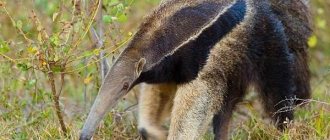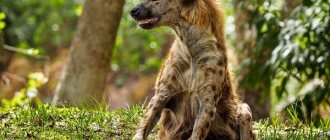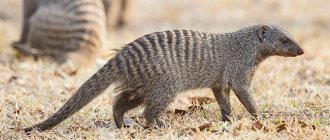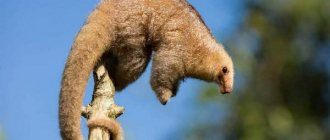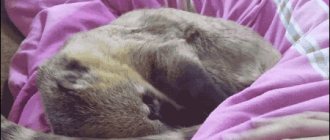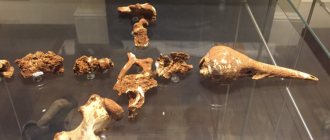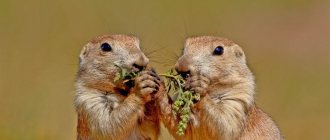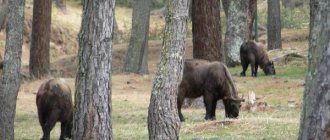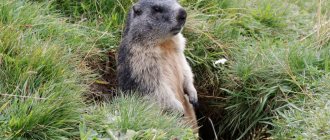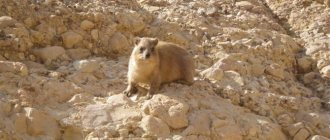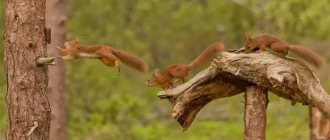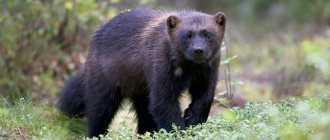- Wild animals
- >>
- Mammals
Numbat is a unique marsupial native to Australia. These cute and funny animals are the size of a squirrel. But despite their small stature, they can extend their tongue half the length of their body, which allows them to feast on termites, which form the basis of their diet. Although numbats are included among the marsupials, they lack a characteristic brood pouch. The small cubs are held by the long curly hair on the mother's belly.
Origin of the species and description
Photo: Nambat
Nambat first became known to Europeans in 1831. The marsupial anteater was discovered by a group of researchers who went to the Avon Valley under the leadership of Robert Dale. They saw a beautiful animal, which at first reminded them of a squirrel. However, having caught it, they were convinced that it was a small yellowish anteater with black and white streaks on the back of its back.
Interesting fact: The first classification was published by George Robert Waterhouse, who described the species in 1836. And the family Myrmecobius flaviatus was included in the first part of John Gould's book The Mammals of Australia, published in 1845, with illustrations by H.H. Richter.
The Australian numbat, Myrmecobius flaviatus, is the only marsupial that feeds almost exclusively on termites and lives exclusively in the geographic distribution area of termites. Millions of years of this adaptation have resulted in unique morphological and anatomical features, particularly related to dental characteristics, that make clear phylogenetic affiliations with other marsupials difficult to discern.
From DNA sequence analysis, the family Myrmecobiidae is placed within the marsupial dasyuromorph, but the exact placement varies from study to study. The uniqueness of Myrmecobius is evident not only in their exceptional feeding habits, but also in their isolated phylogenetic position.
Notes
- Sokolov V. E.
Five-language dictionary of animal names. Mammals. Latin, Russian, English, German, French. / under the general editorship of academician. V. E. Sokolova. - M.: Rus. lang., 1984. - P. 17. - 352 p. — 10,000 copies. - Anteater // Encyclopedic Dictionary of Brockhaus and Efron: in 86 volumes (82 volumes and 4 additional). - St. Petersburg, 1890-1907.
- ↑ 12
Family Myrmecobiidae in Wilson DE & Reeder DM (editors). 2005. Mammal Species of the World. A Taxonomic and Geographic Reference (3rd ed.). — Baltimore: Johns Hopkins University Press, 2 vols. (2142 pp.) ISBN 978-0-8018-8221-0 [1] - ↑ 12
Fisher D., Simon N., Vincent D. The Red Book. Wildlife in danger / trans. from English, ed. A. G. Bannikova. - M.: Progress, 1976. - P. 30-32. — 478 p. - Myrmecobius fasciatus
(English).
The IUCN Red List of Threatened Species
.
Appearance and features
Photo: Nambat animal
The numbat is a small, colorful creature, 35 to 45 cm long including the tail, with a finely pointed snout and a bulbous, bushy tail approximately the same length as the body. The weight of the marsupial anteater is 300-752 g. The length of the thin and sticky tongue can reach up to 100 mm. The coat consists of short, coarse, reddish-brown or gray-brown hairs that are marked by many white stripes. They run along the back and buttocks, giving each individual a unique appearance. A single dark stripe, accentuated by a white stripe underneath, crosses the face and runs around the eyes.
Video: Nambat
The hair on the tail is longer than on the body. The color of the tail is not very different among numbats. It is primarily brown in color with splashes of white and orange-brown on the underside. The hair on the abdomen is white. The eyes and ears are located high on the head. The front paws have five toes, and the hind paws have four. The fingers have strong, sharp claws.
Fun fact: Females do not have a pouch like other marsupials. Instead, there are folds of skin that are covered with short, frilled, golden hairs.
At a young age, the length of the nambat is less than 20 mm. When the young reach 30 mm in length, they develop a light coat of down. The characteristic white stripes appear when the length is about 55 mm. They have the highest visual acuity of all marsupials and it is the primary sense used to detect potential predators. Numbats can enter a state of torpor that can last up to 15 hours a day in winter.
Diet
The marsupial anteater is considered the only animal of its species that distinguishes itself by eating social insects. Mostly these are termites. Other representatives of invertebrates sometimes accidentally fall into its reception. There is information that a numbat is capable of eating 20 thousand insects per day, which is about 10% of the predator’s own body weight. It is most difficult to obtain food in winter, since termites go deep into the soil. Weak claws do not allow the predator to open termite mounds. But when the insects find themselves outside their homes, the ant-eater easily reaches them with the help of its specific tongue.
Its very subtle sense helps the animal successfully search for insects. The numbat swallows its prey from head to toe, without even bothering to chew the hard chitinous shell with which termites are covered.
Read the fact with interest!
Not only zoologists, but even casual witnesses to the marsupial anteater's meal claim that the animal completely loses its vigilance while eating. Many eyewitnesses of his dinner even tried to take the animal from above their hands and stroke it. The pangolin did not express the slightest dissatisfaction against such manifestations of feelings.
Where does the nambat live?
Photo: Nambat marsupial
Numbats used to be widespread in southern Australia and its western regions, from northwestern New South Wales to the Indian Ocean coast. They occupied semi-arid and arid forest and woodland, consisting of flowering trees and shrubs of such genera as eucalyptus and acacia. Numbats were also found in abundance on pastures consisting of Triodia and Plectrachne grasses.
Interesting fact: Their range has decreased significantly since Europeans arrived on the mainland. This unique species survives on only two sites in the Dryandra Forest and Perup Nature Reserve, both located in Western Australia. However, in recent years it has been successfully reintroduced into several protected wildlife areas, including parts of South Australia and New South Wales.
Now they can only be found in eucalyptus forests, which are located at an altitude of about 317 m above sea level, on the damp periphery of the former ridge. Due to the abundance of old and fallen trees, marsupial anteaters feel relatively safe here. Logs from eucalyptus forests play an important role in the survival of animals. At night, numbats seek refuge in hollow logs, and during the day they can hide in them from predators (especially birds and foxes) while remaining hidden in the darkness of the log.
During mating seasons, logs provide nesting sites. The most important thing is that termites feed on the heartwood of most trees in the forests, which form the basis of the diet of numbats. Marsupial anteaters are very dependent on the presence of termites in the area. The presence of this insect limits its habitat. In areas that are too wet or too cold, termites do not live in sufficient numbers and therefore there are no numbats.
Nutrition
The anteater lives in places where there is a lot of vegetation, and therefore insects. In natural living conditions, food for animals is ants and winged termites, and the smallest species of them, due to the lack of teeth. The animal swallows the ants whole. It can absorb up to 30 thousand insects per day. This is where the name of the animal comes from.
Having found the insects' home, it destroys it with the help of its front paws. When the insects run away, the sticky tongue is already overtaking them. The ants are eaten. I don’t mind eating the bee families that are located in the trees. But only climbing dwarf anteaters prefer such a delicacy.
If during the day the animal was unable to find an anthill, then soft larvae of various beetles found in old trees, in the ground, in grass can also serve as prey. While swallowing insects, the anteater tries to crush them against the sky. For better digestion, the anteater licks fine sand and pebbles, which will subsequently grind the food in the stomach.
The habitat of one anteater is quite modest. It is capable of roaming short distances, so they search for food in the vicinity of 1 km. If food is very scarce, then they expand their territories to 2-3 km.
You can see the picture: a wandering giant with his head constantly lowered, constantly sniffing something, sticking out and retracting his long tongue. Their long nose resembles a vacuum cleaner that sucks in something. The animal is very strong, so on its way it turns over old driftwood, trying to find another termite mound.
During the night meal, the anteater's tongue is in constant motion. He is capable of performing 160 motor movements in a minute, licking food on his way. The anteater has very developed salivary glands, so the surface of the tongue is constantly moistened with them.
What does a nambat eat?
Photo: Nambat Australia
The numbat's diet consists mainly of termites and ants, although they may occasionally ingest other invertebrates. By consuming 15,000–22,000 termites per day, numbats have evolved several morphological traits that help them feed successfully.
The elongated snout is used to penetrate logs and small holes in the ground. Their nose is extremely sensitive, and senses the presence of termites by smell and slight vibrations in the ground. A long, thin tongue with saliva allows numbats to gain access to the passages of termites and quickly pull out insects stuck to the sticky saliva.
Fun Fact: The marsupial anteater's saliva is produced from a pair of rather enlarged and complex salivary glands, and its front and hind legs have razor-sharp claws that allow it to quickly dig through termite labyrinths.
The mouth contains 47 to 50 blunt "pegs" instead of regular teeth like other mammals because numbats do not chew termites. The daily diet of termites corresponds to approximately 10% of the body weight of an adult marsupial anteater and includes insects from the genera:
- Heterotermes;
- Coptotermes;
- Amitermies;
- Microcerotermes;
- Termes;
- Paracapritermes;
- Nasutitermes;
- Tumulitermes;
- Occasitermes.
As a rule, the proportions of use depend on the abundance of the genus in the area. Due to the fact that Coptotermes and Amitermies are the most common types of termites in their natural habitat, they are the most commonly consumed. However, nambats have their own special preferences. Some females prefer species of the genus Coptotermes during certain periods of the year, and some marsupial anteaters refuse to eat species of the genus Nasutitermes during the winter.
Interesting fact: During a meal, this animal does not react at all to what is happening around it. At such moments, the nambat can be stroked and even picked up.
Nambat synchronizes its day with termite activity, which is dependent on temperature, from mid-morning to mid-afternoon in winter; in summer it rises earlier, and during the heat of the day it waits and feeds again in the late afternoon.
INTERESTING INFORMATION. DID YOU KNOW THAT...
- The numbat is the only marsupial in Australia that is exclusively diurnal.
- If a nambat is surprised or caught, it never resists and confines itself to hissing.
- The tongue of the nambat has a cylindrical shape and reaches 10 cm in length.
- Nambat eats about 20,000 termites every day.
- At night, the animal falls into a deep sleep, similar to suspended animation.
- The marsupial anteater has a record number of teeth among land mammals, usually from 50 to 52. However, the numbat, accustomed to swallowing food whole, rarely uses them.
Features of character and lifestyle
Photo: Nambat marsupial anteater
The nambat is the only marsupial that is fully active during the day. At night, the marsupial retreats to a nest, which can be in a log, hollow tree or hole. The nest usually has a narrow entrance 1-2 meters long, which ends in a spherical chamber with a soft plant litter of leaves, grass, flowers and shredded bark. The numbat is able to block the opening of its den with the thick skin of its rump to prevent predators from gaining access to the burrow.
Adults are solitary and territorial animals. At the beginning of life, individuals establish a territory of up to 1.5 km² and defend it. Their paths cross during the breeding season, when males venture beyond their normal range to find a mate. When numbats move, they move in jerks. They occasionally interrupt their feeding to analyze their surroundings for predators.
Interesting fact: Sitting upright on their hind legs, numbats keep their eyebrows raised. When excited or stressed, they curl their tail over their back and begin to tear off their fur.
If they feel worried or threatened, they quickly run away, reaching speeds of 20 mph until they reach a hollow log or hole. Once the threat has passed, the animals move on.
GENERAL PROVISIONS
The name "Nambat" was given to the marsupial anteater by the indigenous people of Australia. The animal is small, slightly larger than an ordinary squirrel, and is nocturnal. The nambat's food consists almost entirely of termites. He can also look for them in trees. With lightning-fast movements, the numbat takes out termites one by one with its thin and flexible tongue. He pounces on food with such greed that you can touch him at this time and he will not interrupt his meal. Unlike true anteaters, the marsupial anteater has small teeth.
Nambat has the habit of sleeping so soundly during the day that you can pick him up without waking him up. Because of this feature, it is in danger of extinction. Recently, human-caused forest fires have become more frequent in Australia. Slow marsupial anteaters die in fires because they cannot wake up in time.
Social structure and reproduction
Photo: Nambat animal
In anticipation of the mating season, which lasts from December to January, male nambats secrete an oily substance from a gland located in the upper part of the chest. In addition to attracting a female, the scent also warns other suitors to stay away. Before mating, numbats of both sexes make sounds consisting of a series of soft clicks. Such vocal vibrations are characteristic during the breeding season and in infancy when the baby communicates with its mother.
After copulation, which varies from one minute to an hour, the male may leave to mate with another female or remain in the den until the end of the mating season. However, after the end of the reproductive season, the male leaves the female. The female begins to take care of the cubs on her own. Numbats are polygamous animals and the next season the male mates with another female.
Interesting fact: The reproductive cycles of numbats are seasonal, with the female producing one litter per year. She has several estrous cycles during one breeding season. Thus, females who do not become pregnant or who have lost their children may become pregnant again with a different partner.
Females breed at the age of 12 months, and males become sexually mature at 24 months. After a 14-day gestation period, female nambats give birth to two or four cubs in January or February. Underdeveloped babies, about 20 mm long, travel to the mother's nipples. Unlike most marsupials, female numbats do not have a pouch to house their young. Instead, her nipples are covered with golden hair, which is very different from the long white hair on her chest.
There, the tiny babies intertwine their forelimbs, cling to the hair in the mammary glands, and attach to the nipples for six months. Until they grow so big that the mother cannot move normally. By the end of July, the babies are detached from the nipples and placed in the nest. Even though they are separated from the nipples, they continue to nurse for up to nine months. At the end of September, teenage nambats begin to get food on their own and leave their mother’s den.
Natural enemies of nambats
Photo: Nambat from Australia
Numbates have several adaptations that help them avoid predators. First of all, the forest floor helps them camouflage, because the anteater's fur matches hers in color. Their straight ears are located high on the head, and their eyes look in opposite directions, which allows these marsupials to hear or see enemies approaching them. Unfortunately, their small size makes them easy targets for predators.
There are several main species of animals that hunt numbats:
- Red foxes introduced from Europe;
- Carpet pythons;
- Large falcons, hawks, eagles;
- Wild cats;
- Lizards such as sand monitors.
Even small predator species such as small eagles, which range in size from 45 cm to 55 cm, can easily overwhelm numbats.
Interesting fact: Due to the excessively increased number of predators in forested areas, numbat populations are rapidly declining as they are constantly hunted.
If numbats sense danger or encounter a predator, they freeze and lie motionless until the danger passes. If they are being chased, they will quickly run away. From time to time, numbats may try to ward off predators by producing a hoarse growl. Although they have a relatively small number of sound vocalizations. They may make hissing, growling, or repetitive "quiet" noises when disturbed.
Population and species status
Photo: Nambat
The numbat population began to decline from the mid-1800s, but the fastest phase of extinction occurred in the arid zone in the 1940s and 1950s. The timing of this decline coincided with the importation of foxes into the region. Today, the numbat population is limited to a few forests in southwestern Australia. And even there there were periods of decline in the 1970s, where species disappeared from a few isolated habitats.
Interesting fact: Selective poisoning of foxes since 1983 has been accompanied by a significant increase in numbat numbers, and the increase in animal numbers has continued despite subsequent years of low rainfall. Restoration of populations in areas previously inhabited by numbats began in 1985. Animals from the Dryandra Forest were used to replenish the Boyagin Nature Reserve, where the species became extinct in the 1970s.
Foxes are monitored regularly. Population declines have been influenced by changing fire regimes and habitat destruction, which have reduced the amount of logs that numbats use for shelter from predators, for resting, and as a source of termites. The reproduction of numbats and the appearance of offspring indicate the viability of marsupial anteaters. Today there is significant potential for the movement of animals to other territories.
Natural habitat
Anteaters are widespread in Mexico, as well as in Central America, Brazil and Paraguay. As a rule, the animal's natural habitat is tropical forest zones, but some species are quite well adapted to open areas, savannas and coastal lines.
Anteater species differ in their lifestyle, which is reflected in their physiological characteristics:
- terrestrial giant anteaters
- arboreal pygmy anteaters
- terrestrial arboreal four-toed anteaters
The animal is usually active at night or immediately after dusk. Under natural conditions, the anteater's main source of nutrition is ants and termites, whose nests are destroyed with the help of very powerful forepaws. Insects that have left their devastated home are collected using their sticky tongue and eaten with lightning speed. Somewhat less frequently, anteaters use bees and larvae of various beetles as food. To enhance digestion processes, anteaters are able to periodically swallow coarse sand, as well as fairly small pebbles. The not very well developed organs of vision and hearing are well compensated by an excellent sense of smell, which allows them to find food.
